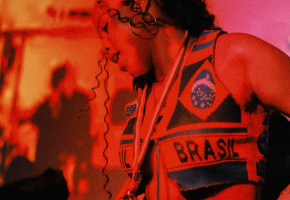Miles Davis once said that João Gilberto could be reading the newspaper and it would sound like something from the heavens. Starting with his 1958 single “Chega de Saudade,” while in his late 20s, Gilberto became the quintessential transmitter of the harmonically and rhythmically complex, lyrically nuanced songs of bossa nova written by Antônio Carlos Jobim, João Donato, Vinicius de Moraes and others.
In the music he recorded from 1958 to 1961 — appearing on the albums “Chega de Saudade,” “O Amor, O Sorriso e a Flor” and “Joao Gilberto” — Mr. Gilberto took strains of Brazilian samba and American pop and jazz and reconfigured them for a new class of young Brazilian city-dwellers, helping to turn bossa nova into a global symbol of a young and confident Brazil.
The music gained particular popularity in the United States, spawning pop hits that brought Mr. Gilberto to Carnegie Hall and led to a Grammy Award, given to him and the jazz saxophonist Stan Getz, for a collaborative effort that was named album of the year for 1964 and that produced an enormous hit, “The Girl From Ipanema.”
Gilberto’s new synthesis replaced samba percussion with guitar-picking figures in offbeat patterns (called by some “violão gago,” or “stammering guitar”). It also conveyed interiority through a singing style that was confiding, subtly percussive and without vibrato.
Gilberto was not much of a songwriter, but his vocal tone, style and interpretations were unique in embodying and ideal of musical restraint and mystery, creating a style that became a sign of the optimism and romance of Brazil in the late 1950s. Until the reality of Rio’s racism and violence was projected onto our screens in Walter Salles’ film City of God, we all believed in the Brazilian dream of bossa nova, and it still represents the idealism and innocence of bygone years.
João Gilberto do Prado Pereira de Oliveira was born in 1931, in Juazeiro, in the northeastern Brazilian state of Bahia, the son of a local businessman and amateur musician, Juveniano de Oliveira, and the youngest of seven children born to Dona Patu, Mr. Oliveira’s second wife. He was sent to boarding school in Aracaju, east of Juazeiro on the Atlantic coast, when he was 11, but left at 15 to play music, serenading locals under a tamarind tree in Juazeiro’s town square.
In his early years Gilberto had a strong, romantic voice, in the popular samba-canção crooning style. He left his hometown for Salvador, Bahia’s capital, in 1949, and a year later he was called to Rio de Janeiro by Alvinho Senna, guitarist for a young vocal quintet, Os Garotos da Lua (the Boys of the Moon), which had a regular performing slot on Rio’s Radio Tupi.
Gilberto left Os Garotos in 1951 and worked sporadically around Rio — accompanying the singer Mariza, recording commercial jingles, taking jobs in a few long-running nightclub revues, becoming a strange and marginal figure around town. When he started refusing to work at clubs where he felt the customers talked too much, he entered a period of poverty, growing his hair long and wearing wrinkled clothes. Then a friend, the singer Luís Telles, brought him to the coast town of Porto Alegre and put him up at a respectable hotel; performing at a local nightclub, Mr. Gilberto gained a following.
After about seven months Mr. Gilberto moved to Minas Gerais, where his older sister Dadainha lived, cloistering himself in his sister’s house, mostly apparently in her bathroom. It was here his sound took shape. The acoustics were reverberant enough for him to practice a whispery, nasal style of singing, audible over the guitar - an inversion of the popular bolero-like style that had dominated Brazilian popular music since the 1930s.
“I felt that the way other singers prolonged the sounds ended up hurting the natural balance of the music,” he said later. “By shortening the sounds of the phrases, the lyrics fit perfectly within the beats and ended up floating.”
When Gilberto returned to Rio in 1957, and his fortunes changed. He was introduced to Antônio Carlos Jobim, who was working as a staff arranger for Odeon Records; Jobim heard Mr. Gilberto’s guitar rhythm and had ideas on how it could be applied to his unfinished song “Chega de Saudade.”
That song, which immortalised the emotion of “saudade,” or longing — was first recorded in May 1958 by Elizete Cardoso, with Gilberto exemplifying bossa nova guitar style: syncopated, swinging, rendered in changeable patterns. In July Gilberto recorded his own version of “Chega de Saudade,” with arrangements by Jobim, in a contentious session at which he insisted — unusual at the time — on separate microphones for his guitar and his vocals.
That single, with an entirely different effect has often been cited as a turning point in Brazilian culture. “It changed my life, and not only my life but the lives of everyone in my generation,” said the singer Gal Costa, 12 years old when that record came out. Caeteno Veloso called it “the manifesto and the masterpiece of a movement: the mother ship.”
The influence went beyond Brazil to astonish American jazz musicians such as Stan Getz and Charlie Byrd. Released in the spring of 1962, it reached No. 1 on the Billboard album chart. That November, Mr. Gilberto traveled to New York for the first time for an appearance at Carnegie Hall as part of a bossa nova package concert.
Pop songs like Eydie Gormé’s “Blame It on the Bossa Nova,” presented bossa nova meant something exotic and slightly upmarket, with a newly American-made dance to go along with it. The phrase had been used to advertise “cashmere sweaters, throw rugs, ice cream and new haircuts,” and in 'Breakfast at Tiffanys', unrequited love could be blamed on Audrey Hepburn's very glamorous Brazilian boyfriend.
After marrying Astrud Weinhardt and taking up residence in the United States in 1963, João Gilberto collaborated with Getz on the album “Getz/Gilberto,” which included “Garota da Ipanema,” sung by both Astrud (in English) and João (in Portuguese). Released as “The Girl From Ipanema,” the song won the 1964 Grammy for record of the year and “Getz/Gilberto” was named album of the year.
After divorcing Astrud and, in 1965, marrying another singer, Heloísa Buarque de Holanda — known as Miúcha — Gilberto moved to Brooklyn before relocating to Mexico, where he recorded the album “João Gilberto en Mexico.” He then returned to the United States, where he stayed until returning to Brazil in 1980.
In the years away from Brazil, Gilberto widened his repertoire to accommodate a few of the great Brazilian songwriters who succeeded him as well as sambas and even boleros. His best work included the minimal, transfixing “João Gilberto” (often referred to as the “white album”) in 1973 and the strings-drenched “Amoroso” in 1977. By the 1980s, many of his recordings were of solo live performances. For a major figure, he produced relatively little: fewer than 10 studio albums under his own name in about 60 years of professional work.
João Gilberto was championed by the generation of Brazilian songwriters that followed him, including Caetano Veloso, Moraes Moreira and Gilberto Gil. His final studio album was “João Voz e Violão” (2000), produced by Mr. Veloso. A few seconds more than half an hour long, it was a mixture of his own old repertoire and songs by Mr. Veloso and Mr. Gil, ending with another version of “Chega de Saudade.”
Through his music, Gilberto radiated a simplicity that could seem like inscrutability. He liked sentimental songs but did not give audiences emotional cues. “Maybe I would like to go back to when I was a boy,” he said. “After that I learned too many things, and they came out in my music. So now I refine and refine until I can get back to the simple truth.”

















